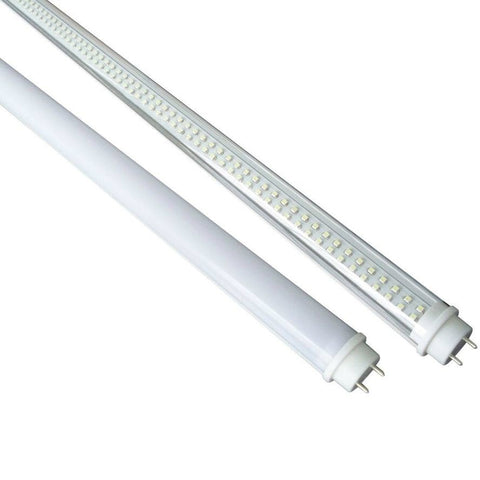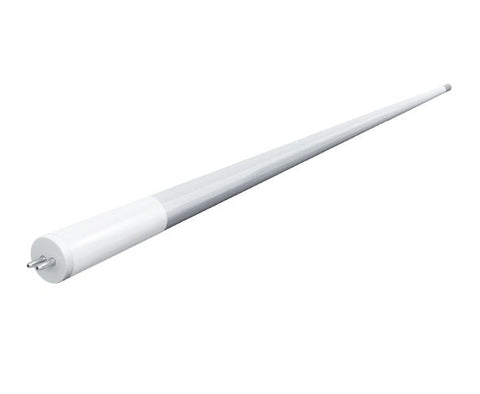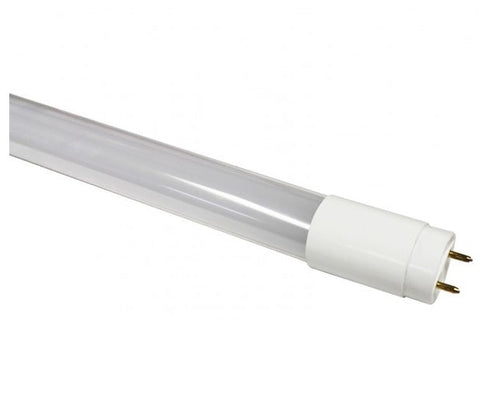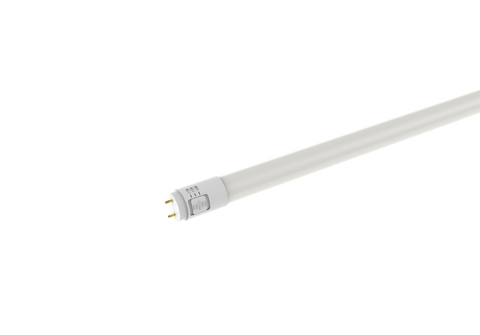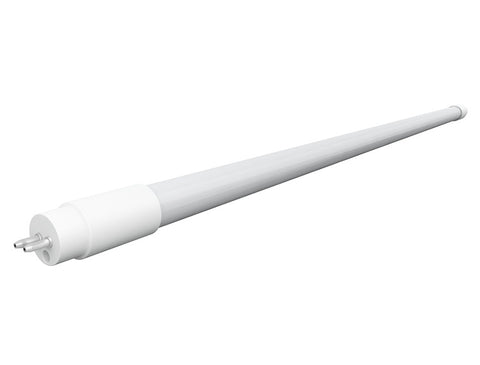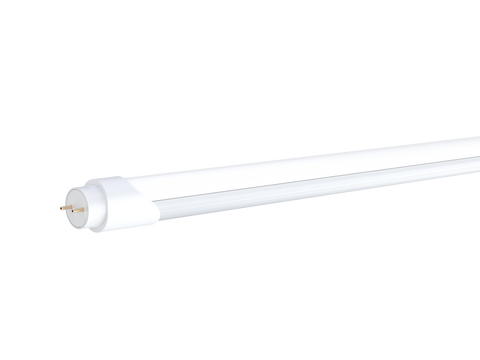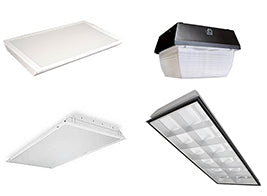Beginning in 2013, T12 linear fluorescent lamps were no longer produced by U.S. lighting manufacturers due to Department of Energy regulations. These regulations were meant to encourage T12 users to upgrade to more efficient T8 and T5 lamps and they directly affect many commercial, industrial and retail businesses. Like the dinosaurs, T12 lamps will soon be extinct and their current users will need to decide the best alternatives for their replacement.
What’s the difference between T12, T8 and T5 lamps?
First, let’s decode what the letters and numbers mean. The “T” stands for Tubular, which is the shape of the glass casing for the lights. The associated number represents the diameter of the lamp. This number is the numerator in a fraction where the denominator is 8 and the length is in inches. For example, with a T12, the diameter is 12/8, or twelve eights of an inch. Another way to say this is that the diameter is equal to 1.5 inches. For a T8, the diameter is 8/8, which is equal to 1 inch. For a T5, the diameter is 5/8, which is equal to 0.625 inches. As you can see, the smaller the number associated with the “T”, the smaller the diameter of the tube.
Next, let’s compare the output and performance of each lamp. It’s important to know how quality and quantity of light is measured in order to compare the different lamps.
Quality of light is typically measured as Color Rendering Index (CRI). CRI is a numerical measure of a light source’s ability to reveal the colors of an object in comparison to a natural light source. To put a lamp’s CRI in perspective, the highest possible CRI is 100 (natural light). Here are the average CRIs for each lamp:
- T12 = 62 CRI
- T8 = 85 CRI
- T5 = 85 CRI
Quantity of light is typically measured in Lumens Per Watt (LPW). This is also known as Luminous Efficacy. LPS is the ratio between the total luminous flux emitted by a light source and the total amount of input power (watts, in this case). Here is the average LPW for each lamp:
- T12 = 78 LPW
- T8 = 90 LPW
- T5 = 99 LPW
As you can see, T5s are smaller in diameter and provide a larger quantity of light. They are also 2-3 times more expensive than T8s. The decision to use T5s or T8s will depend on the desired amount of money to spend on them as well as the application that they will be used for.
Application Guidelines for T8 and T5 Lamps
In most cases, the choice between using T5 or T8 lamps depends on the height of the ceiling that their associated fixtures will be hung or mounted from. A good benchmark to use is whether the fixtures are mounted above or below twelve feet. The difference in light output for T8s and T5s is negligible below twelve feet, so it is recommended that a T8 lamp is used due to its lower cost. In the case of fixtures mounted above twelve feet, the T5 lamp is recommended due to better light dispersion.
T12 Replacement Options
Generally, there are two ways to replace existing T12 lighting systems:
- Replace each lighting fixture with a new one containing more energy efficient components such as ballasts and lamps.
- Retrofit each existing fixture with electronic ballast(s) and T5 or T8 lamps. This may also require replacement of lamp holders. There are a wide variety of retrofit kits that can be used to accomplish this task and it is a great money saving alternative to replacing the entire fixture.
Whatever your needs, it’s time to replace those old T12 lights! See our lamps section to get started.
Consider Watching These Videos as Well...
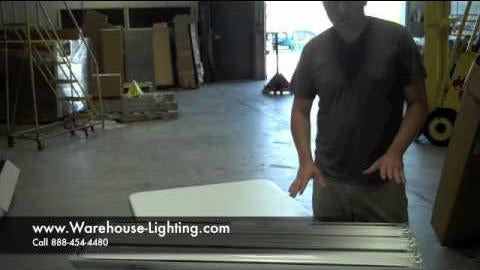
Difference Between T5 and T8 Low Bay Fluorescent Lighting Fixtures
Finding the right lighting solution for your location means comparing your options. When choosing between two types of lighting, there are many factors you may want to consider. For your l...
Watch Video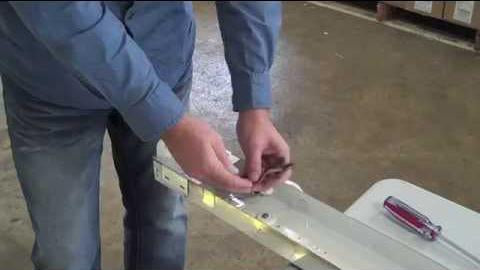
Retro a Fluorescent Strip Fixture to LED
When it comes to saving energy and money with your lighting solutions, LED technology is the way to go. If you already have fixtures in place that you are looking to convert for energy-savings, ...
Watch Video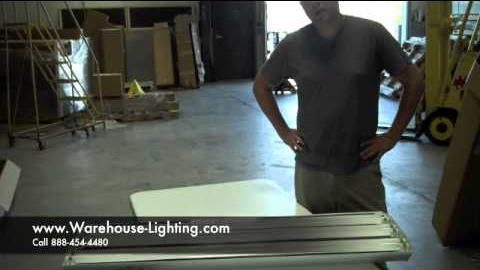
What Are Fluorescent Lighting Electronic Ballasts?
Watch our What Are Fluorescent Lighting Electronic Ballasts? video. Our videos will educate you so that you can confidently purchase and install LED light fixtures, whether they are for a new insta...
Watch Video High Bay LED Lighting
High Bay LED Lighting
 Industrial Low Bay Lighting
Industrial Low Bay Lighting
 Industrial Strip Lights
Industrial Strip Lights
 Vapor Tight Lighting
Vapor Tight Lighting
 LED Shop Lights
LED Shop Lights
 Hazardous Area / Explosion Proof Lighting
Hazardous Area / Explosion Proof Lighting
 Loading Dock Lights
Loading Dock Lights
 Construction / Portable Lighting
Construction / Portable Lighting
 High Temperature LED Lights
High Temperature LED Lights
 Industrial Ceiling Fans
Industrial Ceiling Fans
 LED Work Lights
LED Work Lights
 Networked Controlled Lighting
Networked Controlled Lighting
 NEW Warehouse Lighting Fixtures
NEW Warehouse Lighting Fixtures
 American Made Industrial Lighting
American Made Industrial Lighting
 Clearance
Clearance
 Troffer Lights
Troffer Lights
 LED Flat Panel Lights
LED Flat Panel Lights
 Drop Ceiling Lights
Drop Ceiling Lights
 Suspended LED Lights
Suspended LED Lights
 LED Cylinder Lights
LED Cylinder Lights
 Exit / Emergency
Exit / Emergency
 Wrap Lighting Fixtures
Wrap Lighting Fixtures
 Gooseneck and Barn Lights
Gooseneck and Barn Lights
 Stairway & Corridor Lighting
Stairway & Corridor Lighting
 Hospital Bed Lights
Hospital Bed Lights
 Recessed Lighting
Recessed Lighting
 Wafer Lighting
Wafer Lighting
 RGB LED Lights
RGB LED Lights
 Grow Lights
Grow Lights
 Refrigeration Lighting
Refrigeration Lighting
 Commercial Sign Lights
Commercial Sign Lights
 LED Track Lighting Fixtures & Systems
LED Track Lighting Fixtures & Systems
 UV Disinfecting Lights & Air Purifier Fixtures
UV Disinfecting Lights & Air Purifier Fixtures
 American Made Commercial Lighting
American Made Commercial Lighting
 LED Flood Lights
LED Flood Lights
 Outdoor Wall Lights
Outdoor Wall Lights
 LED Area Lights
LED Area Lights
 Parking Lot Lights & Poles
Parking Lot Lights & Poles
 Outdoor Post Top Lights
Outdoor Post Top Lights
 LED Stadium Lighting
LED Stadium Lighting
 Canopy Lights
Canopy Lights
 Security & Motion Sensor Lights
Security & Motion Sensor Lights
 LED Bollard Lights
LED Bollard Lights
 Outdoor LED Linear Light Fixtures
Outdoor LED Linear Light Fixtures
 Solar Powered LED Lighting
Solar Powered LED Lighting
 Dusk to Dawn Lights
Dusk to Dawn Lights
 Landscape Lighting
Landscape Lighting
 Outdoor String Lights
Outdoor String Lights
 Coastal Wildlife Lighting
Coastal Wildlife Lighting
 Outdoor House Lights
Outdoor House Lights
 American Made Outdoor Lighting
American Made Outdoor Lighting
 Architectural Linear Lights
Architectural Linear Lights
 Architectural Grid Mount Lights
Architectural Grid Mount Lights
 Architectural Round Pendant Lights
Architectural Round Pendant Lights
 Architectural Square Linear Lights
Architectural Square Linear Lights
 Architectural X-Shaped Linear Lights
Architectural X-Shaped Linear Lights
 Architectural LED Wall Packs
Architectural LED Wall Packs
 Ceiling Fans
Ceiling Fans
 Ceiling Lights
Ceiling Lights
 Chandelier Lights
Chandelier Lights
 Pendant Lighting
Pendant Lighting
 Island Lights
Island Lights
 Under Cabinet Lighting
Under Cabinet Lighting
 Vanity Lights
Vanity Lights
 Wall Sconces
Wall Sconces
 LED Tape Lights
LED Tape Lights
 LED Mirrors
LED Mirrors
 LED Light Bulbs
LED Light Bulbs
 LED Tube Lights
LED Tube Lights
 LED Corn Lights
LED Corn Lights
 Vintage LED Bulbs
Vintage LED Bulbs
 Decorative LED Bulbs
Decorative LED Bulbs
 Fluorescent Light Bulbs
Fluorescent Light Bulbs
 Metal Halide Lamps
Metal Halide Lamps
 LED Magnetic Strip Retrofit Kits
LED Magnetic Strip Retrofit Kits
 LED Strip Light Retrofit Kits
LED Strip Light Retrofit Kits
 High Bay LED Retrofit Kits
High Bay LED Retrofit Kits
 LED Troffer Retrofit Kits
LED Troffer Retrofit Kits
 LED Wall Pack Retrofit
LED Wall Pack Retrofit
 LED Street Light Retrofit Kits
LED Street Light Retrofit Kits
 Recessed Lighting LED Retrofit Kits
Recessed Lighting LED Retrofit Kits
 Ballasts & Drivers
Ballasts & Drivers
 Emergency Ballast For LED & Fluorescent Lights
Emergency Ballast For LED & Fluorescent Lights
 Electrical Supplies & Mounting Kits
Electrical Supplies & Mounting Kits
 Electrical Tools
Electrical Tools
 Switches & Receptacles
Switches & Receptacles
 Electrical Power Cords
Electrical Power Cords
 Sensors and Timers
Sensors and Timers
 Smart Home Automation
Smart Home Automation
 High Bay Occupancy Sensors
High Bay Occupancy Sensors
 Electric Vehicle Chargers
Electric Vehicle Chargers
 Hand Dryers
Hand Dryers
 LED Shop Lights
LED Shop Lights
 Garage LED Light Fixtures
Garage LED Light Fixtures
 Office Lights
Office Lights
 Classroom Lights
Classroom Lights
 Church Lights
Church Lights
 Gym Lighting
Gym Lighting
 Factory Lights
Factory Lights
 Hospital Lights
Hospital Lights
 Walkway Lights
Walkway Lights
 Parking Lot Lights
Parking Lot Lights
 Exterior Building Lights
Exterior Building Lights
 Sports Lighting
Sports Lighting
 Airport Lights
Airport Lights
 NSF Rated Lights
NSF Rated Lights
 Restaurant Lights
Restaurant Lights
 Corridor Lights
Corridor Lights
 Barn Lighting
Barn Lighting


